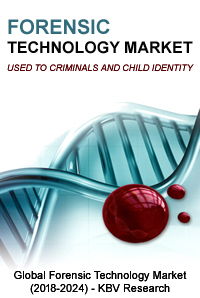Forensic Technology Market (2018-2024) | KBV Research
Forensic technology is a major tool in the
court of law. Rising crime rates and the growing need to solve delicacy crimes
using advanced technologies are influencing the growth of the forensic technologies
industries. Furthermore, government initiatives in funding to support forensic
research is leading to better innovations in the forensic ecosphere.
Premeditated homicide, murder, and other critical crimes are demanding
forensics on a rapid pace.
Companies are expanding across market
horizons. Which also increases the risk of fraud, bribery, and corruption. As
regulators and law enforcement bodies strengthen their international
collaboration, the cost associated with non-compliance is also mounting.
Outdates risk assessments, unnoticed fraud, and inadequately executed
investigations, followed by failure to remediate internal controls, only aggravate
the risks for companies. In such scenarios, these technology plays an
imperative role in detecting potential fraud.
Driving
Forces
 |
| Global Forensic Technology Market (2018-2024) - KBV Research |
With developments in forensic technology,
law prosecution has more tools and resources at its disposal. As a result,
criminals are facing barriers in getting away with their actions. Accordingly,
the mandate for this type of technology has only augmented over time.
Furthermore, public interest in forensics has risen, especially with the
prominence of crime based television shows.
Despite the perceptions about the
possibilities and impossibilities, there have been some extraordinary forensics
technology improvements in recent years. The technology advancements are
serving law enforcement in solving the crime and shut the cases on cold cases
across the globe.
According to recent research established by
KBV
Research, one of the leading market research companies, the global
market for Forensic Technology is very likely to reach $20.79 billion by 2024,
growing at a CAGR of 6.7% during the forecast years.
DNA Profiling
DNA profiling determines an individual’s
DNA characteristics which are unique like a fingerprint. This is a forensic
technique in criminal investigations which compares criminal suspects’ profile
to DNA evidence. It is also used for parentage testing to determine immigration
eligibility.
Chemical Analysis
For processing chemical analysis, a
forensic chemist can assist in identifying unfamiliar materials found at crime
scenes. Specialists have a wide assortment of methods and instruments which can
help in identifying unknown components. This analysis can provide leads for
investigators. The identification of various substances at a scene can
determine for an investigator what to look for during their search.
Forensic chemical analysis can also narrow
the suspect list to people who have access to substances used in a crime.
Forensic firearm analysis examines the
characteristics of firearms and any cartridges or bullets that are left behind
at a crime scene. Forensic investigators typically depend on the collection of
some sort of ballistics evidence, whether it is the actual firearm or
projectile, and link a suspect to a firearms crime. For instance, details
including the type of guns fired at the specific distance and angles, and the
exact sequence of the event can be determined with firearm analysis.
Trends & Developments
Massively Parallel Sequencing is an
emerging trend in the worldwide market of Forensic
Technology Market. This technology provides more information about DNA
evidence in comparison to conventional forensic technologies. More information
will be critical in solving missing person cases. Rapid DNA technology uses DNA
to connect families that are moving into a specific country. Further, forensic
analysts can use this technology to solve crimes. Time-tracing fingerprint
technology is being widely used to determine if a suspect’s fingerprints are
present at the scene of a crime.
Modern marvels in the forensic industry
including DNA analysis and image enhancement technologies have made forensic
science easier in various aspects. Some of the modern breakthroughs in this
innovation include LABRADOR (Light-weight Analyzer for Buried Remains and
Decomposition Odor Recognition). This device sniffs out chemicals released by
decaying bodies.
Although new technologies are still under
development, DNA analysis is being considered as the primary route of forensic
analysis.
Click
Here For Free Insights: https://www.kbvresearch.com/news/forensic-technology-market-size/
KBV Research - Market Research & Consulting Company
Phone No: +1 (646) 661-6066 | Email id: query@kbvresearch.com
Address: 244 Fifth Avenue, Suite 1407 New York, N.Y. 10001 United States (U.S)






Comments
Post a Comment